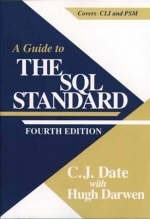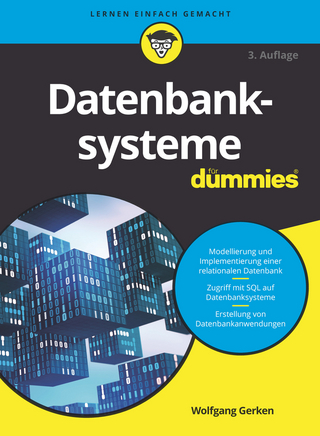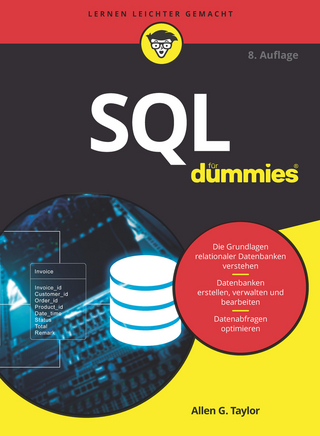
A Guide to SQL Standard
Addison Wesley (Verlag)
978-0-201-96426-4 (ISBN)
- Titel ist leider vergriffen;
keine Neuauflage - Artikel merken
The SQL language has established itself as the linqua franca database management; it provides the basis for systems interoperability, application portability, client/server operation, distributed database, and more, and is supported by just about every DBMS on the market today. SQL2 - or, to give it its official name, the International Standard Database language SQL (1992) - represents a major set of extensions to the earlier SQL standard. For a start, the new specification is well over 600 pages, compared with less than 100 for the original version. No database professional can afford to ignore it. Features *Thorough revision of the official ANSI standard for SQL. *Covers all important new SQL2 features including extensive integrity support, powerful new operators, national and international character data support and comprehensive date and time support.
*Continues the tradition of careful, clear, and accurate explanations of complex technical material Features New to this Edition *Covers extensive integrity support, powerful new operators, national and international character data support, all features of SQL2; comprehensive date and time support and clear explanation of the complexitites of Dynamic SQL, all features of SQL2. *Provides first tutorial treatment available anywhere of the brand new and dramatically extended version of SQL known informally as SQL2 or SQL/92. 0201964260B04062001
C. J. Date is an independent author, lecturer, researcher, and consultant specializing in relational database systems, a field he helped pioneer. Among other projects, he was involved in technical planning for the IBM products SQL/DS and DB2. He is best known for his books, in particular, An Introduction to Database Systems (7th edition, Addison-Wesley, 2000), the standard text in the field, which has sold well over half a million copies worldwide. Mr. Date is widely acknowledged for his ability to explain complex technical material in a clear and understandable fashion. Hugh Darwen has been involved in software development since 1967 as an employee of IBM United Kingdom, Ltd. He has been active in the relational database arena since 1978. He was one of the chief architects and developers of an IBM relational product called Business System 12, a product that faithfully embraced the principles of the relational model. He has been an active participant in the development of SQL international standards since 1988. 0201964260AB04062001
(Most chapters begin with "Introduction".)I. INTRODUCTION.
1. Why Sql is Important.
Background.
Is a Standard Desirable?
2. An Overview of Sql.
Introduction.
Data Definition.
Data Manipulation.
Cursor Operations.
Views.
Security and Integrity.
Recovery and Concurrency.
Schemas and Catalogs.
Sessions and Connections.
II. Some Preliminaries.
3. Basic Language Elements.
SQL Language Characters.
Tokens and Separators.
Key Words.
Identifiers and Names.
Scope of Names.
Notation.
4. Catalogs and Schemas.
The SQL-Environment.
Catalogs.
Schemas.
5. Connections, Sessions, and Transactions.
SQL-Agents
SQL-Connections
SQL-Sessions.
SQL-Transactions.
6. Binding Styles.
Introduction.
The Module Language.
Embedded Sql.
Direct Sql.
III. Data Definition and Manipulation.
7. Scalar Objects, Operators, and Expressions.
Introduction.
Data Types.
Literals.
Scalar Operators and Functions.
Aggregate Functions.
Assignments and Comparisons.
8. Data Definition: Domains and Base Tables.
Introduction.
Domains.
Base Tables.
9. Data Manipulation: Noncursor Operations.
Introduction.
Single-Row SELECT.
Insert.
Searched Update.
Searched Delete.
10. Data Manipulation: Cursor Operations.
Introduction.
Cursors.
Cursor-Based Manipulation Statements.
A Comprehensive Example (Module Version).
A Comprehensive Example (Embedded SQL Version).
11. Table Expressions.
Introduction.
Join Expressions.
Table References.
Unions, Differences, and Intersections.
Table Primaries.
Select Expressions.
Derived Table Column Names.
12. Conditional Expressions.
Introduction.
General Remarks.
Comparison Conditions.
BETWEEN and LIKE Conditions.
IN and MATCH Conditions.
ALL-Or-ANY Conditions.
EXISTS Conditions.
UNIQUE Conditions.
A Final Remark.
13. Views.
Introduction.
Data Definition Operations.
Data Manipulation Operations.
The Check Option.
IV. DATA CONTROL.
14. Integrity.
Introduction.
Domain Constraints.
General Constraints.
Base Table and Column Constraints.
Foreign Keys.
Deferred Constraint Checking.
15. Security.
Introduction.
Authorization Identifiers.
Privileges and Access Rules.
GRANT and REVOKE.
The Grant Option.
RESTRICT Vs CASCADE.
V. ADVANCED TOPICS.
16 Missing Information and Nulls.
Introduction.
Effect of Nulls on Scalar Expressions.
Effect of Nulls on Conditional Expressions.
Effect of Nulls on Table Expressions.
Effect of Nulls on Integrity Constraints.
A Recommendation.
17. Dates and Times.
Introduction.
Data Types.
Literals.
Time Zones.
Data Conversion.
Scalar Operators and Functions.
Assignments and Comparisons.
18. Temporary Tables.
Introduction.
Type 1: "Declared" Temporary Tables.
Types 2 and 3: "Created" Temporary Tables.
19. Character Data.
Introduction.
Properties of Character Strings.
Character Sets and Collations.
Data Types.
Literals.
Scalar Operators and Functions.
Assignments and Comparisons.
Character Sets For Identifiers.
20. Dynamic Sql.
Introduction.
What is The Problem?
Statement Preparation and Execution.
SQL Descriptor Areas.
Cursor Operations.
Session Defaults.
21. Information Schemas.
Introduction.
Information Schema Tables.
22. Exception Handling.
Status Codes.
The Diagnostics Area.
23. Call-Level Interface.
Introduction.
What is The Problem?
CLI Routines and Parameters.
CLI Resources and Related Matters.
Statement Preparation and Execution.
CLI Descriptor Areas.
Placeholders.
Retrieval Operations.
Exception Handling.
A Sample "SQLCLIH" File.
A Sample CLI Application.
APPENDIXES.
A. An Sql Grammar.
Introduction.
Sessions, Connections, and Transactions.
Data Definition.
Modules.
Data Manipulation.
Table Expressions.
Conditional Expressions.
Constraints.
Dynamic Sql.
Scalar Expressions.
Get Diagnostics.
Miscellaneous.
B. Language Levels and Conformance.
Introduction.
Intermediate Sql.
Entry Sql.
SQL Flagger.
C. Sql/92 Vs Sql/89.
Introduction.
Extensions.
Incompatibilities.
Deprecated Features.
D. Some Outstanding Issues.
Introduction.
The Issues.
E. Persistent Stored Modules.
Introduction.
Overview.
Routines, Modules, and Schemas.
Type Precedence.
Subject Routine Determination.
SQL Control Statements.
Exception Handling.
External Routines.
Miscellaneous Topics.
F. An Overview of Sql3.
Introduction.
Data Definition and Manipulation.
Functions and Operators.
Integrity.
Security.
Transactions.
G. References and Bibliography. 0201964260T04062001
| Erscheint lt. Verlag | 6.3.1997 |
|---|---|
| Verlagsort | Boston |
| Sprache | englisch |
| Maße | 160 x 230 mm |
| Gewicht | 770 g |
| Themenwelt | Mathematik / Informatik ► Informatik ► Datenbanken |
| Mathematik / Informatik ► Informatik ► Software Entwicklung | |
| ISBN-10 | 0-201-96426-0 / 0201964260 |
| ISBN-13 | 978-0-201-96426-4 / 9780201964264 |
| Zustand | Neuware |
| Haben Sie eine Frage zum Produkt? |
aus dem Bereich


